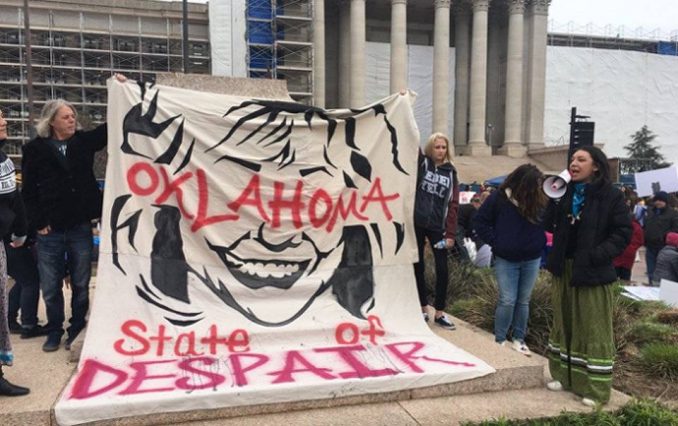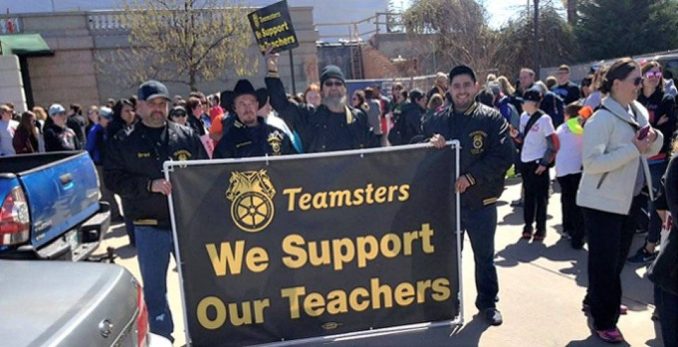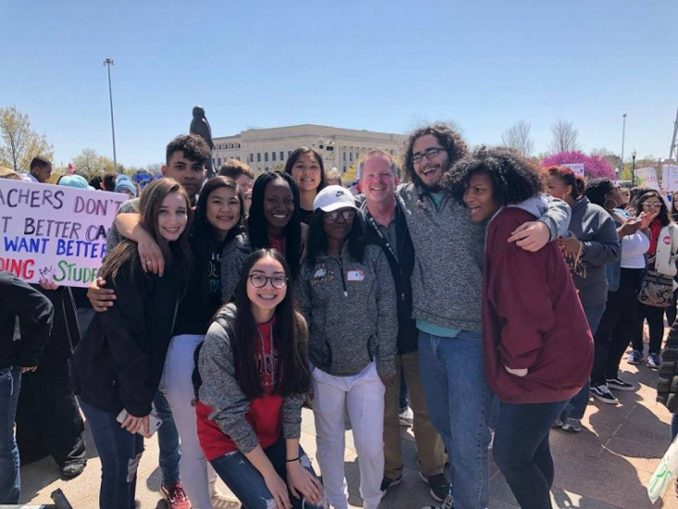Oklahoma education workers defy and push forward
 By Ben C. and Sara C.
By Ben C. and Sara C.
Oklahoma City, Okla.
As the walkout by Oklahoma teachers completes its first week on Friday, April 6, schools in districts serving the majority of the state’s students are officially closed as righteously angry educators continue to pack the Legislature building and grounds. According to the Oklahoma Education Association (@okea twitter), Friday’s goal was to obtain education funding of $84 million yearly via taxes on online purchases like Amazon, allowing “ball and dice” games at casinos, and rejecting the repeal of a $5 tax on hotel/motel stays.
OEA President Alicia Priest sent out an action alert at the end of Friday’s legislative day, announcing victory in the passage of the online tax and casino tax bills. But the hotel/motel tax was not repealed, and she asked members to push the governor to veto that.
Priest added: “Lawmakers should expect to see us at the Capitol on Monday, fighting for the passage of capital gains legislation.” Ending capital gains deductions could generate $120 million in state income, especially from corporations.

Teamsters Local 886 refused to cross the education workers’ picket line to do renovations on the state Capitol.
Beginning on Monday, April 2, tens of thousands of teachers, school workers, students and community members have shuttered schools across Oklahoma and rallied inside and out of the Capitol building. The contradiction of resource-poor classrooms on oil-rich land is so sharp that even many district administrators endorse this mobilization as necessary to bridge the funding gap.
Generally speaking, these workers are not defying management but are confronting the state institutions that actually determine their pay and the education budget: Oklahoma’s governor and the state Legislature. Other unions have joined the ongoing demonstrations at the Capitol building as well, including state workers’ Oklahoma Public Employees Association denouncing their own low pay. Teamsters are driving shuttle vans for demonstrators and have refused to cross education workers’ picket lines. Oklahoma Education Association members include public school teachers, coaches, counselors, librarians, nurses, custodians, cafeteria workers, bus drivers, secretaries and other support personnel.
Community support
The National Indian Education Association issued a statement of support for the strike, noting: “More than 100,000 Native students attend public schools in the state. They deserve a quality education provided by adequately funded schools. With their strike, Oklahoma educators are demanding the state fulfill its responsibility and fully fund public schools and provide raises to educators. Funding for textbooks, supplies and professional development are critical and are necessary to create positive, culturally responsive learning environments where students can be inspired and thrive.”
On April 4, a hundred teachers began a 110-mile march from Tulsa to the Capitol in Oklahoma City to dramatize their commitment to better schools for all. Marcher Aaron Baker confirmed to WW that the date was chosen to align with the #MLK50 commemorations in Memphis. He and other protesters that WW met prior to Wednesday are now posting scenes of children lined up to give them high-fives, and of other Oklahomans providing food and first aid. As of Friday morning, a newsok.com poll asking, “Do you support the teacher walkout?” had an over 86 percent “yes” response from some 24,000 online readers.
High school students held their own rally April 3 outside the state house, backing the goals of the walkout. Though the emphasis may have been on voting in the future, these youth are realizing their organizing power, and some are highly class conscious. As Noah Frost of the Edmond North Young Socialists told WW: “It’s important for students to stand with the teachers not only because we are also fighting for our own education, but to promote class unity and consciousness. This whole movement is more than just asking for more pay, it’s standing up to the ruling classes to demand what’s right.”
The progressive movement in the capital has chimed in as well. The Oklahoma Peace House took out paid full page ads in the two largest Sunday papers, showing that this state pays the lowest tax on oil profits of all oil-producing states. Local women’s, Indigenous, Black Lives Matter, LGBTQI, environmental, pro-Cuba and pan-African organizations are among those helping to arrange food and housing in Oklahoma City for out-of-town teachers, as well as library enrichment for out-of-school youngsters. Activist Camille Landry told WW that these groups support the teacher unions’ efforts on principle, despite the unions’ failure so far to center their issues and voices—and the statistical likelihood that many of this week’s demonstrators voted for the bigot-in-chief Trump.
Recent attempts by lawmakers such as Gov. Mary Fallin to undermine support for the walkout include labelling marchers as “outside agitators,” “actors,” “paid protesters” and “Antifas”; and assigning the state Bureau of Investigation to look into “threats made against legislators.” These code words may work on convinced right-wingers, but could also teach people involved in their first protest movement to ultimately identify with other movements that are treated similarly and worse by the media and state.

Del City High School student president, Xavier Turner (center), spoke to the massive April 4 walkout rally at the Capitol.
No-strike orders defied
Many schools across the state have remained closed throughout the week, during which major standardized testing had been set to begin in the younger grades. Education workers are vowing to remain out of the classrooms until their demands are met and education is fully funded by the Legislature and governor. Certain districts have reopened schools and demanded that teachers and school workers return, with mixed results. In solidarity, teachers in districts with vacancies are encouraging colleagues to apply for another job at a more supportive site.
Western Heights, considered an urban and poor small district in Oklahoma City, had lawyers issue a threat to dock striking teachers for the cost of hiring substitutes (about $87 a day). The next day, at least one marcher’s sign read, “Western Heights, we walk for you too.” In fact, 30 Western Heights staff defied the order. By Thursday, district teachers resolved the problem by organizing field trips to bring classes to the Capitol in yellow buses! (tinyurl.com/y8p8apym)
Impressions from the ground
“They want to shut down and privatize public services and make them to be for profit,” a veteran Oklahoma teacher, Tom Smith, told WW. “That’s why we see all these things about charter and private schools. Nobody’s making any money [on public schools]. That’s why you see everybody wanting to privatize your pension funds, and so forth. We need to solve the root cause and then we can begin to heal up.”
Smith was one of hundreds who gladly received solidarity handouts from Workers World and the Southern Workers Assembly in the first two days of the strike.
Every day, education workers have filled the grounds of the Capitol building in what resembles in many ways an encampment, setting up canopies with the names of their school districts, and even conducting classes for students. Thousands have packed the plaza on the south side of the building for daily rallies. These rallies, in addition to featuring Oklahoma school workers, parents and students, have included West Virginia teachers, have acknowledged the strikes by education workers taking place in Kentucky and elsewhere, and have included defiant calls to continue to return to the Legislature en masse each day until demands are met.
The atmosphere outside the building also has a marked tone of jubilant resistance, featuring cultural performances, music, dancing and a generally celebratory environment. Many carry creative, homemade signs that reiterate the call for full funding, or highlight the abysmal state of education in Oklahoma, including textbooks that are 20 years old, crumbling school buildings and other deplorable conditions. Some signs point to the role that the big oil and gas companies in the state play and demand that they pay up to fund education. Other signs draw the connection between the massive amount the state spends to incarcerate people compared to the meager funding it provides for education.
Long lines that last throughout the day snake around the Capitol building from both entrances as education workers and their supporters have also maintained a strong presence each day inside the halls of the Legislature. Packing the rotundas of each of the four floors of the building — in a scene that is reminiscent of the state Capitol takeover by state workers in Wisconsin in 2011 — education workers fill the building each day with speeches and chants. When the House or Senate have been in session, hundreds of teachers pack the seating area and the narrow halls outside the doors leading to the chambers, drowning out the sessions with chants for full funding of education.
After Oklahoma Gov. Fallin compared education workers to “a teenage kid that wants a better car,” many pursued her when she appeared on Thursday at the Capitol, jangling their keys in the air and chanting, “Where’s my car?”
Big Oil & Jim Crow
Oklahoma teachers are ranked 49th in pay countrywide. Only Mississippi and South Dakota rank lower. (In addition to the 50 states, the District of Columbia is included in the ranking.) Ninety of the state’s 500 school districts have switched to a four-day school week due to a lack of funding to keep schools open for a full five-day week.
The state is also one of the top five petroleum and shale producing states in the country. The U.S. Energy Information Administration reports that oil production in Oklahoma has increased by two and a half times since 2005. However, Oklahoma taxes oil and gas production at the lowest rate in the U.S. — a dismal 2 percent. House Bill 1010xx, passed just prior to April 2 under the pressure of the impending teacher and school worker strike, raises that to a paltry 5 percent for three years and possibly 7 percent afterwards. Big Oil pipelines are often built on Native lands and there have been many struggles — and some victories — by Indigenous peoples to stop their construction.
Cuts to education were higher in Oklahoma than in any other state following the 2008 Great Recession, with state funding for public schools cut by 23.6 percent between 2008 and 2014. The schools, the public sector and the people of Oklahoma were robbed to ensure that the oil and gas industry in particular, and other big business in general, would continue to make greater and greater profits.
Harold Hamm — net worth estimated at $18.7 billion — is one of the biggest oil industry heads in the state. Hamm personally attended the recent vote on House Bill 1010xx to raise the tax on oil and gas production in the state. WW correspondents heard several reports that Hamm has cynically bused in oil and gas employees “any time they discuss the gross production tax” to help his efforts to lower taxes on his industry.
Lyman Nichols and Doug Law — two of the other major oil industry executives in the state — have been targeted along with Hamm by demonstrators. A Native-led group of protesters placed a banner denouncing “the Oligarchy” over a state-sponsored tribute to that industry on the day the strike began.
Oklahoma education workers are directly confronting Jim Crow right-to-work (for less!) and other anti-worker laws in the state through their actions. Racism — against Indigenous peoples, Black and migrant workers — has long been a tool the bosses have used to divide the working class and break apart worker struggles that have opened in Oklahoma.
The fight against white supremacy is part and parcel of the class struggle, and as the resistance in Oklahoma continues to unfold, it will be critical to find more opportunities to take on that fight to build greater unity against the interests of Big Oil, the banks, and the politicians who do their bidding and impose harsh austerity measures on communities.
As education strikers continue to push forward in Oklahoma on April 5, news is breaking that teachers in Washington, D.C., are also staging a walkout against underfunded school conditions there. These teachers are placing their action in the broader context of the uprising being led by education workers in Oklahoma, Kentucky, Puerto Rico, Arizona, West Virginia and elsewhere.
This burgeoning struggle against austerity cuts and for meeting people’s needs shows signs of continuing to expand in the days and weeks ahead — with teachers and school workers in the lead.



